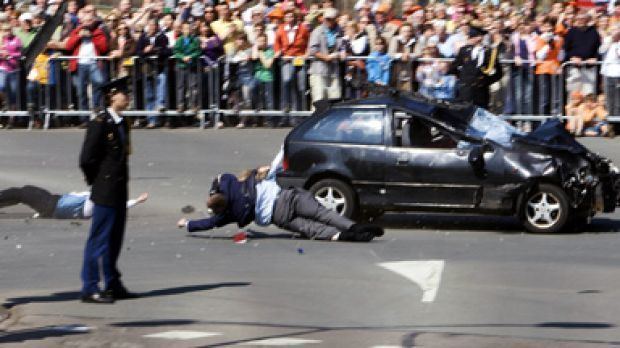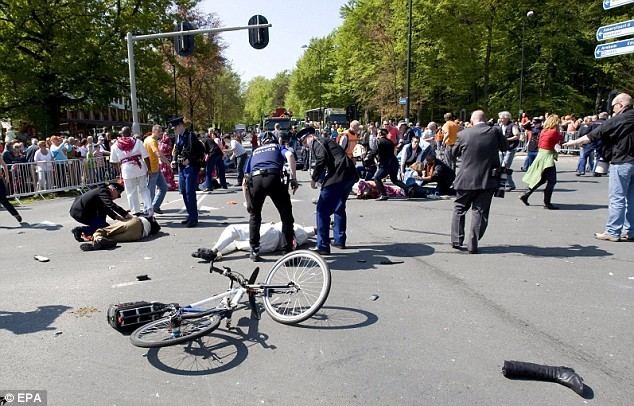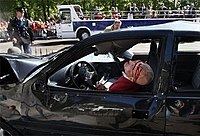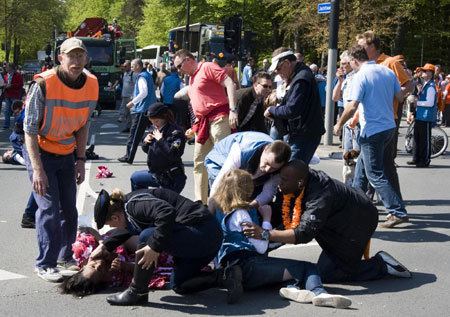Attack type Car attack Non-fatal injuries 10 Start date April 30, 2009 | Weapons Suzuki Swift Perpetrator Karst Roeland Tates | |
 | ||
Deaths 8 (including the attacker) Similar Beatrix of the Netherlands, Willem Alexander of the Netherlands, Queen Máxima of the Netherlands | ||
The 2009 attack on the Dutch Royal Family occurred on 30 April at Apeldoorn, Netherlands, when a man drove his car at high speed into a parade which included Queen Beatrix, Prince Willem-Alexander and other members of the royal family. The occasion of the attack was the Dutch national holiday of Koninginnedag (or Queen's Day).
Contents

The vehicle drove through people lining the street watching the parade, resulting in eight deaths and ten injuries. It missed the Royal Family and crashed into a monument at the side of the road. No members of the Royal Family were harmed. It was the first attack on the Dutch Royal Family in modern times.

The driver, identified as 38-year-old Dutch national Karst Roeland Tates, was attended by emergency service workers of the fire brigade and police, taken into custody and transported to the hospital for treatment. He died the day after the incident, the seventh person to succumb to injuries suffered during the attack. A 46-year-old woman died from her injuries days later, on 8 May, bringing the total number of deaths to eight.

Location of the attack

At around 11:50 am, just before an open-top bus carrying the Dutch Royal Family made its last turn towards the palace of Het Loo in Apeldoorn, a black older-model Suzuki Swift crashed through the onlookers, just missing the bus carrying the Royal Family members, and slammed into De Naald, an obelisk-shaped Royal monument. Seconds after the attack Red Cross and Police first aiders were on site to provide the basic life saving treatments to the 17 victims, who were all taken to nearby hospitals. After the crash, the vehicle was examined by the anti-terrorist department and local police.

The attack and search were shown on live TV. Members of the Dutch Royal Family who were waving at the crowds gathered were shown standing up to look over at the crashed car, shocked and gasping with their hands over their mouths.
Attacker

Karst Roeland Tates (6 March 1971 – 1 May 2009), a 38-year-old Dutchman, was identified as the driver of the car. After the attack, he was rescued by the fire department and transferred to a hospital where he was treated for his injuries. Tates was from Huissen, a small town in the eastern Netherlands, and had no criminal record.
Tates died in the early morning of 1 May of brain injuries sustained in the crash. An autopsy was performed, no traces of alcohol were found in his blood.
Tates' motive remains unclear. He had called his mother to congratulate her on her birthday on the day before the attack and said he was looking forward to her birthday party on 3 May. He left no indication he was planning anything. Tates' parents describe him as kind and attentive, and although there had been periods of financial trouble in his past, he had recently found work. According to his parents, Tates held no ill will towards the Royal Family and had described the Queen as a "stabilizing force".
However, other reports revealed that Tates "had embarked on a mission of vengeance against society after losing his job as a night-shift security guard" earlier in the year, and had been facing eviction from his house. He told a neighbour he was depressed and had been out of contact with family for months.
The official investigation established that the attack was premeditated but not well prepared. The report said the people killed were probably innocent bystanders who were watching the parade. Tates did not intend to kill many people; he had scouted the situation beforehand but when he returned for his assault the situation had changed and people were standing in a previously cordoned-off street.
The public prosecutor assumed Tates acted alone and feared that his actions would never be totally explained.
Aftermath
A few hours after the attack Queen Beatrix addressed the nation in an emotional video message.
What started out as a beautiful day has ended in a terrible tragedy that has shocked all of us. People who were standing nearby, who saw it happen on television, all those who witnessed it, must have been watching in astonishment and disbelief. We [the Royal Family] are speechless that something so terrible could have happened. My family, myself, and, I think, every person in the country feels for the victims, their families and friends, and all who have been affected by this incident.
At a press conference that afternoon police reported that Tates, who was still conscious but severely injured after the accident, had told police that it was a deliberate act aimed at the Royal Family. He had no prior history of psychological problems and there are no indications that any sort of terrorist group was involved. Initial rumours that the car was rigged with explosives were later denied by the police.
Cancelled events
Following the attack, at 12:15 pm local time, it was announced that all planned celebrations in Apeldoorn were cancelled. Later that day, many other events across the Netherlands were also cancelled, shortened or toned down significantly – including all activities in Rotterdam and many events in Amsterdam.
As the news of the attack spread, many people spontaneously lowered the national flag to half-staff (the normal flag instruction on Queen's Day is to fly the flag, with orange banner, at full-staff, and many people follow this instruction). Prime Minister Jan Peter Balkenende announced the order to lower all flags on government buildings to half-staff.
Initially, it was feared that the supposed "act of madness by a lone attacker" endangered the long-held yearly tradition with the Royal Family's mingling with the Dutch people on Queen's Day.
Memorial service
On 8 May, a memorial service was held in the Orpheus theatre in Apeldoorn, with speeches by Prime Minister Jan-Peter Balkenende and mayor of Apeldoorn Fred de Graaf. It was attended by the Queen, the Prince of Orange, Princess Máxima, Princess Margriet and Pieter van Vollenhoven as well as 1,200 guests. Some 5,000 people watched the ceremony on screens placed outside on Apeldoorn's central market square and millions more on live television. Just hours after the memorial, it was announced that after being in critical condition for over a week, an eighth person had died of injuries sustained in the attack.
Monument
On 29 April 2010, Queen Beatrix and Mayor De Graaf unveiled a monument for the seven victims, near the location of the attack. The work by artist Menno Jonker resembles a box containing seven blue and white balloons, representing vulnerability, festivity and mourning.
